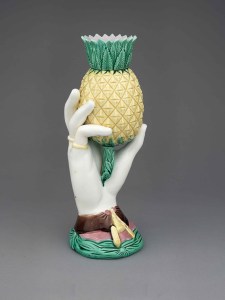This article was published in the March 2020 issue of Apollo. Preview the current issue and subscribe here.
The first time I visited the majolica collection of one of the largest lenders to our upcoming exhibition, I remember feeling a bit bewildered by the concentration of material in front of me – shelves upon shelves of teapots and game-pie dishes, jugs and ornamental figures, garden seats and jardinières – many in the form of moulded animals or embellished with exuberant historicist decoration. I recall thinking, where does one begin to understand this glorious excess? The combination of vibrant colours and sheer diversity of objects was reminiscent of a Victorian interior in its density of display, yet it complemented this sleek Manhattan apartment in a wholly contemporary manner. It was the first of many paradoxes that encounters with majolica would present – and this was just the beginning of an ‘Alice Through the Looking-Glass’ type of visual journey that has culminated in the exhibition and catalogue ‘Majolica Mania: Transatlantic Pottery in England and the United States, 1850–1915’.

‘Shell’ ware made in c. 1879–80 by Griffen, Smith & Co. Private collection. Photo: Bruce White

Peacock (shape no. 2045), designed in c. 1873 by Paul Comoléra and manufactured by Minton & Co. The English Collection, Baltimore. Photo: Bruce White
Majolica, one of the most significant innovations in 19th-century ceramics, was introduced to the public by the renowned English firm Minton & Co. at the Great Exhibition of 1851. The eccentric designs and flamboyant polychrome lead-based glazes of this new ware captured the attention of consumers on both sides of the Atlantic. From the time of its debut, however, majolica posed a host of inherent contradictions, and thus proved to be a rewarding subject of enquiry. Although at first largely inspired by Renaissance ceramics, the ware represented a technological advance in the British pottery industry and was therefore seen as modern. Frequently designed and decorated by known sculptors and painters, it was also mass-produced in mechanised factories. Considered a triumph of art and industry upon its introduction, by the early 20th century, after its popularity had waned, it was criticised for its supposedly vulgar application of ornament and would be essentially ignored for the next 70 years. And perhaps the most sobering contradiction that we explore in the exhibition is that the great appeal of majolica – its whimsy and rich colourful glazes – came at significant human cost. In most potteries, the ware was painted by women and girls. The dangers of working in close proximity with lead-based glazes were well known throughout the period, but safety reforms would not be enacted until the late 1890s. Potters and paintresses routinely became ill, and many lost their lives while making majolica – we honour these individuals in the exhibition with a stupa-shaped memorial, commissioned from the contemporary ceramic artist Walter McConnell.

Vase designed in c. 1868 and manufactured by Wardle & Co. Collection of Sheldon M. Rice, New York. Photo: Bruce White
In the course of our research, we have expanded the majolica narrative beyond what has typically been a connoisseurial overview of the productions of a few principal makers. The recovered histories of more than a dozen English manufacturers range from those of Thomas Forester, the ‘Potter King of Longton’, who used modern marketing techniques to sell inexpensive ceramics to millions, to Eliza Wardle, who, in the 1870s and ’80s, grew Wardle & Co., the firm founded by her late husband, into one of the most successful in Staffordshire. Our scholarship sheds new light on the output and business practices of these important but mostly undocumented makers. An assessment of the contributions made by immigrant English potters who settled in the towns of East Liverpool, Ohio, Trenton, New Jersey and Baltimore, Maryland, the centres of ceramic production in the United States during the second half of the 19th century, has also been fundamental to broadening the scope of this project. With their practical experience and technical skills – their knowledge of clays, glaze chemistry, and mould-making – these potters were to become the foundation of the American ceramic trade. We celebrate their collective endeavours alongside the grander productions of the elite English firms – illustrating both continuity and ingenuity across the industry, as well as how majolica reached all levels of Victorian society, from the British royal family to the American farmer’s wife.
Beyond the many compelling stories of designers, makers, retailers, and collectors, the majolica objects, in all of their fanciful eccentricity, have provided a window into 19th-century culture and society; and it is in exploring this realm that the cheese stands, trinket trays, spoon warmers, and moustache cups become most meaningful. As an embodiment of the era’s ever-expanding consumer culture; of its middle-class social angst; of its popular preoccupations, such as botany and zoology; as well as its satirical commentaries on other issues of the day, majolica’s significance transcends the inevitable cycles of taste that precipitated its decline.
As we near the end of proofreading the three-volume, 1,000-page exhibition catalogue, it is my sincere hope that ‘Majolica Mania’ will spark a much-needed reconsideration of this important aspect of 19th-century culture.
‘Majolica Mania: Transatlantic Pottery in England and the United States, 1850–1915’ is at the Bard Graduate Center from 24 September–2 January 2022.
From the March 2020 issue of Apollo. Preview the current issue and subscribe here.
Unlimited access from just $16 every 3 months
Subscribe to get unlimited and exclusive access to the top art stories, interviews and exhibition reviews.














![Masterpiece [Re]discovery 2022. Photo: Ben Fisher Photography, courtesy of Masterpiece London](http://zephr.apollo-magazine.com/wp-content/uploads/2022/07/MPL2022_4263.jpg)
The threat to Sudan’s cultural heritage